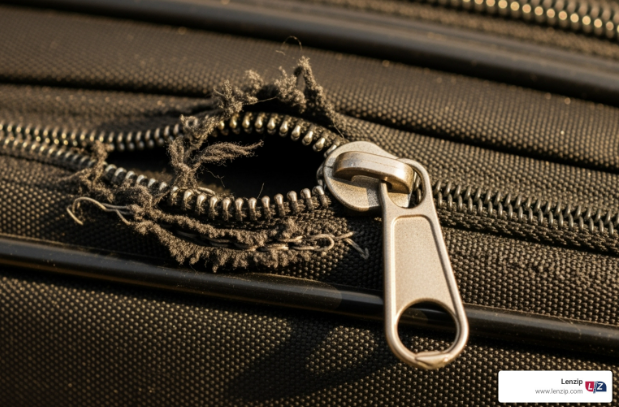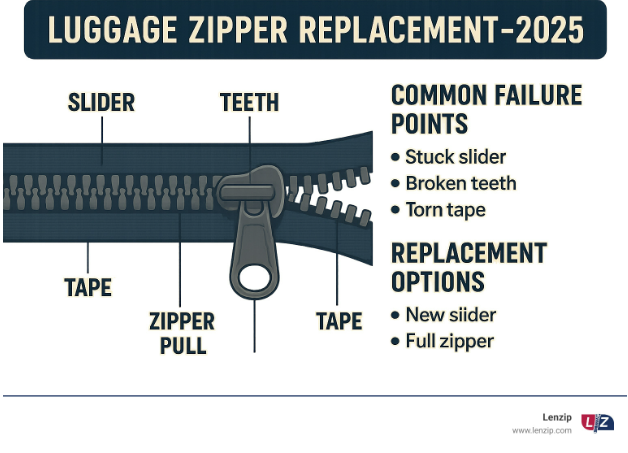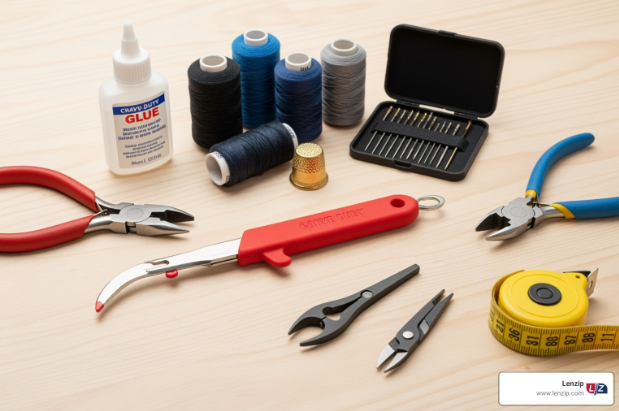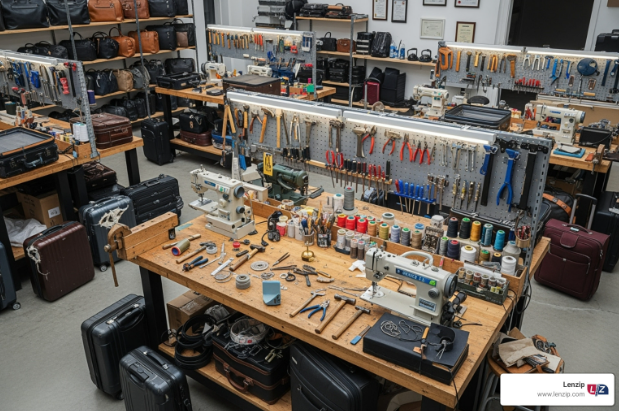Luggage Zipper Replacement:
Top Picks for a Smooth Journey
Don’t let a broken zipper ruin travel! Get expert tips on luggage zipper replacement, DIY fixes, parts, and when to get professional help.
Top Picks for a Smooth Journey
Luggage zipper replacement can save you hundreds of dollars and extend the life of your favorite travel gear. Whether it’s a stuck slider, broken teeth, or a detached zipper, most problems can be fixed with the right parts and approach.
Quick Solutions for Common Zipper Problems:
- Stuck zipper: Try graphite from a pencil or candle wax as lubricant
- Broken slider: Replace with a new slider (no sewing required)
- Missing zipper pull: Attach a new pull tab or use a paperclip temporarily
- Separated teeth: Full zipper replacement needed
- Torn zipper tape: Professional repair or full replacement required
It’s incredibly frustrating when a suitcase zipper fails right before a trip. As one traveler shared: “You struggle to close your suitcase, the zipper breaks, and you leave tomorrow with no time to buy a new bag.”
The good news is that most failures are due to the slider—the component that moves along the teeth. Zipper specialists estimate that the slider wears out, falls off, or breaks in about 80% of cases. This means many “broken” zippers only need a simple part replacement.
With repair kits under $20 and professional fixes from $75-125, repairing your luggage makes financial sense, especially when quality suitcases cost $200-500 or more.


First, Diagnose the Damage: Repair or Replace?
Before starting a luggage zipper replacement, you need to diagnose what went wrong. Understanding the cause helps you decide between a quick fix and a full replacement.
The most common culprit is a worn-out slider. Over time, the slider can stretch and lose its grip on the zipper teeth, causing them to separate as you zip.
Overstuffing damage is another frequent offender. Forcing a zipper on an overpacked bag can bend the slider, misalign the teeth, or tear the zipper tape.
Sometimes the problem is simpler: fabric threads caught in the mechanism, dirt buildup, or a broken zipper pull that’s snapped off completely. These issues are often easier to fix than you’d think.
For temporary fixes on the go, try using pliers to gently squeeze a stretched slider back into shape, or apply wax lubrication (like lip balm) to help a stuck zipper glide smoothly.
To assess the damage, check if the zipper’s basic structure is intact. If the teeth are attached to the tape and the tape isn’t torn, a repair is likely possible. However, separated zipper teeth or torn fabric usually require a full replacement.
Understanding Zipper Anatomy: Finding the Right Parts
With the problem diagnosed, let’s cover zipper anatomy. Understanding the parts is key to finding the right replacements for your luggage zipper replacement.
A zipper consists of several key parts. The tape is the fabric strip holding the teeth, which must mesh perfectly. The slider moves along the teeth to open or close the zipper. The pull is the handle for the slider, and stops at the top and bottom prevent the slider from coming off. The chain refers to the tape and all its attached components before the slider is added.
Coil zippers, made from nylon, are lightweight and flexible, making them ideal for curved areas on luggage. Heavy-duty versions are very durable.
Metal zippers are strong and reliable. You’ll find them on premium luggage where durability is key, offering a classic, high-quality look.
Plastic-molded zippers are workhorses. Each tooth is molded onto the tape, creating a durable, rust-proof zipper available in many colors that can withstand rough handling.
Many suitcases use two-way separating zippers with two sliders, letting you open the bag from either end.
Zippers have sizes, like #3, #5, #8, or #10. This gauge indicates the width of the closed teeth. Getting the right size is crucial. You can often find this number on the back of the slider or measure the width of the closed teeth yourself.
For a deeper understanding of zipper components, explore our Zipper Terminology guide. For a general overview, you can also consult external resources like the Wikipedia page on zippers.
Simple Fixes vs. Full Replacement
Here’s where we separate the quick victories from the bigger projects. Understanding the difference can save you time and money.
When to repair: If the slider is not closing teeth properly, it’s likely stretched. A gentle squeeze with pliers can tighten it, or you can use a no-sew replacement slider for a quick fix.
A stuck zipper might just need lubrication and patience. If thread or fabric is caught in the mechanism, carefully remove it with tweezers.
When to replace: If there are missing teeth along the track, the zipper’s integrity is compromised. A temporary fix won’t be reliable, so replacement is necessary.
Torn zipper tape is another clear sign that full replacement is needed. The fabric strip that holds the zipper teeth is the foundation of the system; when it’s damaged, the whole zipper needs to go.
The same goes for teeth that have separated from the tape entirely. Once that bond is broken, there’s no reliable way to reattach them. This damage typically happens from severe stress or age.
Many travelers successfully tackle these repairs. Some report completing a full luggage zipper replacement by hand in about 30 minutes. With quality parts and patience, you can restore your luggage for a fraction of the cost of a new bag.

Finding Replacement Sliders
If you only need to replace a faulty slider, you’ve found the most cost-effective and satisfying fix. The replacement slider must match the zipper type (coil, metal, etc.) and size (gauge number). For luggage, you’ll often need two sliders for two-way zippers. Decide if you want locking sliders for security or non-locking ones for easy access.
No-sew replacement sliders clamp onto the existing zipper without sewing, making them perfect for emergency fixes. Traditional replacement sliders require removing the old one and installing the new one with pliers, offering a more permanent solution.
Finding Full Zipper Chains
When the tape is torn or teeth are damaged, a complete luggage zipper replacement is necessary. Zipper by the yard is continuous chain sold by length, perfect for long or curved zippers. You buy the length you need and add your own sliders and stops. Separating zippers, like those on jackets, come apart completely at the bottom and are sometimes found on expandable sections.
When measuring for the correct length, be precise. It’s easier to trim a zipper that’s too long than to stretch one that’s too short. For complex repairs, understanding how zippers interact with other materials is helpful. You can find more information at our webbing page.
All-in-One Zipper Repair Kits
For the DIY enthusiast, an all-in-one zipper repair kit is an affordable investment, usually under $20. A typical kit includes:
- Pliers: For removing and tightening parts.
- Top and bottom stops: To keep the slider on track.
- Assorted sliders: For different zipper types and sizes.
- Zipper pulls: To replace broken tabs.
Some kits also include tools like seam rippers, providing everything you need for most zipper emergencies.
Your Toolkit for a Full Luggage Zipper Replacement
A full luggage zipper replacement gives your travel companion a new lease on life. While replacing a slider is simple, a full zipper replacement requires more patience and the right tools.

Your toolkit should include a seam ripper to carefully remove the old zipper without damaging the fabric. Precision is crucial, so work slowly.
You’ll need heavy-duty thread. Regular thread isn’t strong enough for luggage; one DIYer’s repair failed quickly for this reason. Use nylon or polyester upholstery thread for a lasting repair.
You’ll also need strong needles that can handle thick luggage fabric, possibly a curved one for tight spots. A thimble is essential to protect your fingers when pushing through tough material.
Flat-nose pliers help pull needles through stubborn spots and crimp on new zipper stops. A measuring tape ensures accuracy, while fabric glue can temporarily hold the new zipper in place for alignment.
For very thick materials, a stitching awl can pre-punch holes, making sewing much smoother.
Step-by-Step: A Quick Guide to Luggage Zipper Replacement
The process of luggage zipper replacement is straightforward but requires attention to detail. First, remove the old zipper using a seam ripper to unpick the stitches. Rushing can damage the luggage fabric.

Aligning the new zipper is critical. Position it exactly where the old one was, pinning it securely. Ensure it’s straight and the slider glides smoothly. For two-way zippers, check that both sliders are positioned correctly.
For hand-sewing techniques, use heavy-duty thread and a strong needle. A reliable stitch involves bringing the thread up beside a zipper tooth, going down in the same space to create a loop, then bringing the needle up in the next space, running it through the loop, and pulling tight. This creates a durable connection.
Using a sewing machine can be faster if you have a heavy-duty model, but maneuvering bulky luggage can be challenging.
Finishing the repair involves trimming excess thread and installing new top and bottom stops with pliers to keep the slider from coming off.
Tips for a Durable Repair
A long-lasting repair comes down to the details. Using heavy-duty thread is non-negotiable.
Reinforcing stitches at the beginning, end, and at stress points adds extra insurance against failure.
Proper alignment is key. A crooked zipper will wear out faster. Take extra time during the pinning stage.
Finally, test the zipper thoroughly. Open and close it multiple times to ensure it holds strong before you pack for your next trip.
When to Call a Professional for Your Luggage
While DIY projects are satisfying, sometimes the smartest move for a luggage zipper replacement is to call a professional.
Expensive or high-end luggage often warrants professional repair to protect your investment. A DIY mistake could be costly, turning a simple repair into a full replacement.
Complex curved zippers are tricky. The sleek, curved lines on modern luggage require specialized equipment and experience to replace properly.
Structural damage beyond the zipper is another reason to seek professional help. If the case is cracked or the surrounding fabric is torn, a repair shop can address all issues comprehensively.
Warranty considerations can save you money. Some brands offer guarantees that cover zipper issues. Always check your warranty first, as a DIY attempt might void it. As one forum user noted, “I wish I’d checked my warranty before attempting the repair myself!”
Time pressure is a valid concern. If you need a quick turnaround before a flight, a professional can often provide same-day or next-day service.
The cost-benefit analysis often favors professional repair. While DIY kits are under $20, professional work costs $75 to $125. For luggage that cost $200+, a professional repair is a sound financial and environmental choice, extending its life and keeping it out of a landfill.

Finding a Reputable Repair Service
Finding the right professional for your luggage zipper replacement is straightforward. Local cobblers are a great option, as they regularly work with heavy-duty materials and have the right equipment. Many shoe repair shops also service bags and luggage.
Luggage stores often offer repair services or can refer you to a trusted repair center. They can provide realistic timelines and cost estimates.
Authorized repair centers are ideal for branded luggage. Check the manufacturer’s website for a list of approved centers that have access to original parts.
Online mail-in services are another option, especially if local services are unavailable. Research reviews carefully and understand their policies on shipping and timing.
Frequently Asked Questions about Luggage Zipper Repair
Here are answers to some of the most common questions about luggage zipper replacement and repair.
Can any broken luggage zipper be fixed?
Most common zipper problems are fixable. A broken slider, missing pull, or slightly misaligned teeth can often be repaired with a DIY kit or simple tools like pliers.
However, damage like teeth that have separated from the fabric tape or an extensively torn tape requires professional expertise and equipment.
Assess your luggage’s overall condition. If it’s a sturdy suitcase with one problem, repair makes sense. If the bag has multiple issues or severe damage, the cost of repair may not be worth it.
How much does it cost to replace a luggage zipper?
The cost of luggage zipper replacement depends on your approach.
DIY repairs are very budget-friendly. Repair kits are typically under $20, and individual parts like no-sew sliders can cost just a few dollars.
Professional repairs cost more, typically running between $75 to $125. The final price depends on the zipper’s complexity, the luggage type, and local labor rates.
While $75 may seem steep, it’s almost always less than buying new luggage. For a $200 suitcase, a repair extends its life for many more trips, making it a smart financial and environmental choice.
Your Partner in Production
We understand that every project is unique, which is why we offer the flexibility you need. Our B2B focus means we can support your business with options that work for you, including minimums as low as 25 units. We are not just a supplier; we are your partner, committed to helping you find the right solution to fit your specific requirements.
Let’s Find the Right Solution for You
Ready to upgrade to the Lenzip standard? We’re here to help.
Talk to a representative today. We’ll help you find the right solution for your project
Call us at (847) 368-9000 or request a quote today.
